
Bitburg is a city in Germany, in the state of Rhineland-Palatinate approximately 25 km (16 mi.) northwest of Trier and 50 km (31 mi.) northeast of Luxembourg city. The American Spangdahlem Air Base is nearby.

Daun is a town in the Vulkaneifel district in Rhineland-Palatinate, Germany. It is the district seat and also the seat of the Verbandsgemeinde of Daun.

Wittlich is a town in Rhineland-Palatinate, in western Germany, the seat of the Bernkastel-Wittlich district. Its historic town centre and the beauty of the surrounding countryside make the town a centre for tourism in southwest Germany.

Musweiler is an Ortsgemeinde – a municipality belonging to a Verbandsgemeinde, a kind of collective municipality – in the Bernkastel-Wittlich district in Rhineland-Palatinate, Germany.

Wallscheid is an Ortsgemeinde – a municipality belonging to a Verbandsgemeinde, a kind of collective municipality – in the Bernkastel-Wittlich district in Rhineland-Palatinate, Germany.

Binsfeld near Wittlich in the Eifel is an Ortsgemeinde – a municipality belonging to a Verbandsgemeinde, a kind of collective municipality – in the Bernkastel-Wittlich district in Rhineland-Palatinate, Germany. Nearby is the American Spangdahlem Air Base.
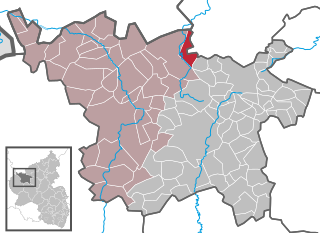
Nohn is an Ortsgemeinde – a municipality belonging to a Verbandsgemeinde, a kind of collective municipality – in the Vulkaneifel district in Rhineland-Palatinate, Germany. It belongs to the Verbandsgemeinde of Gerolstein, whose seat is in the like-named town.

Oberbettingen is an Ortsgemeinde – a municipality belonging to a Verbandsgemeinde, a kind of collective municipality – in the Vulkaneifel district in Rhineland-Palatinate, Germany. It belongs to the Verbandsgemeinde of Gerolstein, whose seat is in the like-named town.

Stolzenfels Castle is a former medieval fortress castle ("Burg") turned into a palace, near Koblenz on the left bank of the Rhine, in the state of Rhineland-Palatinate, Germany. Stolzenfels was a ruined 13th-century castle, gifted to the Prussian crown prince, Frederick William in 1823. He had it rebuilt as a 19th-century palace in Gothic Revival style. Today, it is part of the UNESCO World Heritage Site Upper Middle Rhine Valley.

Trier Hauptbahnhof is a railway station for the city of Trier, in the German state of Rhineland-Palatinate. It is a through station, about 500 metres (550 yd) east of the inner city and the Porta Nigra.

The Koblenz–Trier Railway is a railway line in the German state of Rhineland-Palatinate, located mostly on the left (northern) bank of the Moselle, connecting Koblenz via Bullay to Trier. It is known in German as the Moselstrecke, i.e. "Moselle line". It is often called the Moselbahn links der Mosel to distinguish it from the Moselle Railway (Moselbahn) or Moselle Valley Railway (Moseltalbahn), which ran on the right (southern) bank of the Moselle from Bullay to Trier, but was abandoned in the 1960s. The line was built as part of the Cannons Railway (Kanonenbahn) and opened in 1879.
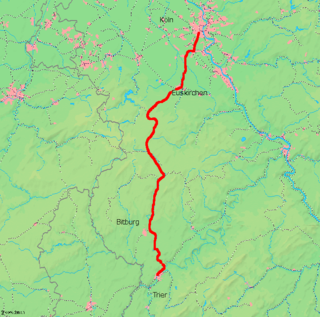
The Hürth-Kalscheuren–Ehrang railway is a non-electrified line in the German states of North Rhine-Westphalia and Rhineland-Palatinate running from Hürth-Kalscheuren via Euskirchen and Gerolstein to Trier-Ehrang through the Eifel hills.
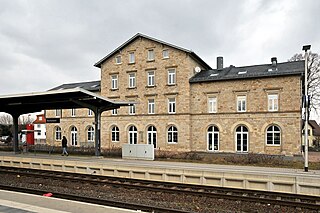
Monsheim station is in the municipality of Monsheim in the Alzey-Worms district of the German state of Rhineland-Palatinate. It is at the junction of the Rheinhessen Railway, the Palatine Northern Railway and the Zeller Valley Railway. The station’s entrance building is protected as a monument. It is classified by Deutsche Bahn as a category 5 station.
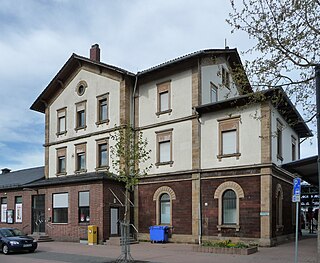
Grünstadt station is a railway junction where the Palatine Northern Railway connects with the Eis Valley Railway and the disused tracks of the Leiningen Valley Railway and the Worms–Grünstadt railway. It is one of three stations in the urban area of Grünstadt in the German state of Rhineland-Palatinate. The station's entrance building of 1873 as well as parts of the premises are protected as monuments. It is classified by Deutsche Bahn as a category 4 station.

The Trier West Railway a 14 km-long railway line running from Trier-Ehrang in the German state of Rhineland-Palatinate to Wasserbillig in Luxembourg via Trier-West. The double-track, electrified section between Trier-Ehrang and the Moselle bridge at Konz forms a bypass of the Trier rail node.
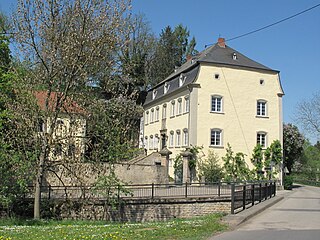
Schloss Holsthum, also called Herrenhaus Laeis, is a manor house in the municipality of Holsthum in the county of Eifelkreis Bitburg-Prüm in the German state of Rhineland-Palatinate. It is a cultural monument and listed building.

The Cross Eifel Railway is a non-electrified railway line between Andernach and Gerolstein in the Eifel in the German state of Rhineland-Palatinate. From Andernach to Mayen Ost (East), it is classified as main line and it has two tracks as far as Mendig.

Gerolstein station is a station on the Eifel Railway in Gerolstein in the German state of Rhineland-Palatinate. Its former function as an important junction station, however, has been lost with the closure of the Cross Eifel Railway (Eifelquerbahn) and the West Eifel Railway (Westeifelbahn). It is the only remaining station in the town.

Bitburg-Erdorf station is a station on the Eifel Railway in Bitburg in the German state of Rhineland-Palatinate. The Nims–Sauer Valley railway (Nims-Sauertalbahn) branched off here to the now closed Bitburg Town station, the remaining part of which is only used for freight traffic and occasional excursion trains. Today Bitburg-Erdorf station is the only station in Bitburg that is served by regular passenger services.

The Rhineland-Palatinate General Directorate for Cultural Heritage is a state agency responsible for monument protection and preservation in the Rhineland-Palatinate. In addition to the Directorate of Castles, Palaces and Antiquities, its responsibilities include the three state museums in Koblenz, Mainz and Trier as well as the State Monument Preservation and State Archaeology Directorates as monument authorities.

























